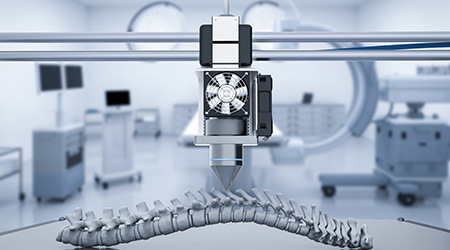When the COVID-19 pandemic began in March 2020, the world quickly adapted to a new normal. People began working from home more, empty store shelvesbecame common, and most industriesbegan implementing new technologies.
At the forefront of the pandemic, the healthcare industry had little time to waste. Hospitals across the country moved toward telemedicine and e-check-ins and check-outs, and those adaptations are only the beginning. Hospitals and other healthcare facilities have begun to incorporate augmented reality (AR) and the internet of things (IoT) to help provide better care for its patients.A growing number of facilities managers are experimenting with 3Dprinting, though someremainunsure of thebenefits the technology brings to facilities.
“The 3D printing of medical devices is at the forefront of innovation and health care,” William Maisel, director of the office of product and evaluation and quality with the Center for Devices and Radiological Health, the branch of the U.S. Food and Drug Administration (FDA) responsible for the premarket approval of medical devices, said in a press release. “3D printing at hospitals and other patient-care settings enables health care professionals to quickly create patient-matched devices and anatomical models for surgical planning, as well as many other uses that can help health care facilities rapidly respond to patient needs.”
In December, the FDA released a discussion paper, “3D Printing Medical Devices at the Point of Care” to foster a discussion regarding the benefits and challenges of 3D printing at hospitals and other healthcare facilities. The technology mightserve an important public health purpose in terms of point of care as it may provide for rapid production of devices.
According to the paper, 3D printing can take different forms at the point-of-care level based depending on the circumstances. For example, the technology must rely on the healthcare facility’s printing capabilities, and expertise and experience factor in whether it is appropriate for a patient.
The COVID-19 pandemic has increased the use of 3D printing because many industries faced supply chain disruptions. As a result, healthcare facilities have been able to collaborate with manufacturers to produce face shields, face mask holders, nasopharyngeal swabs, and ventilator parts from locally available materials and additive manufacturing.
For something to be 3D printed, technicians first must create a digital design of the object. For patient-specific objects, this can be achieved through patient imaging files. Converting the image into a digital design requires engineering expertise, and only then can they make the final object.
The FDA has reviewed more than 100 products developed through 3D printing. The agency does not regulate the printers but the medical devices that are being made.
Despite the precautions, there are still concerns aboutthe technology. According to the FDA’s discussion paper, healthcare facilities still need to be sure that 3D printed devices at the point-of-care stage are safe and effective, provide appropriate control of devices, clarify the responsible entity, and ensure training capabilities.
A report by ECRI found that 3D printing is among the top 10 hazards in the healthcare industry. According to the report, if a patient-specific device is created without appropriate verification of the design, quality control of the manufacturing process, and validation of the product, the object might not accurately represent the patient’s anatomy and will not perform as intended. Because of this issue, procedure delays are possible, as are complications, infections,and injuries.
Without appropriate measuresput in place for all aspects of the printing process, patients could be at risk. Meanwhile, not all hospitals have theneeded experts onhand because of budget restrictions, location, or staffing shortages.As a result, it remains uncertain whether hospitals and other healthcare facilities will use additive manufacturing.
Mackenna Moralez is assistant editor with Healthcare Facilities Today.

 UF Health Hospitals Rely on Green Globes to Realize Their Full Potential
UF Health Hospitals Rely on Green Globes to Realize Their Full Potential How Healthcare Facilities Can Be Truly Disaster-Resilient
How Healthcare Facilities Can Be Truly Disaster-Resilient TriasMD Breaks Ground on DISC Surgery Center for San Fernando Valley
TriasMD Breaks Ground on DISC Surgery Center for San Fernando Valley Bigfork Valley Hospital Falls Victim to Data Breach
Bigfork Valley Hospital Falls Victim to Data Breach AI-Driven Facilities: Strategic Planning and Cost Management
AI-Driven Facilities: Strategic Planning and Cost Management